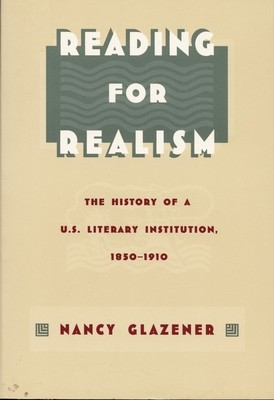
- We will send in 10–14 business days.
- Author: Nancy Glazener
- Publisher: Duke University Press
- ISBN-10: 0822318709
- ISBN-13: 9780822318705
- Format: 15.3 x 22.8 x 2.8 cm, softcover
- Language: English
- SAVE -10% with code: EXTRA
Reviews
Description
Reading for Realism presents a new approach to U.S. literary history that is based on the analysis of dominant reading practices rather than on the production of texts. Nancy Glazener's focus is the realist novel, the most influential literary form of the nineteenth and twentieth centuries-a form she contends was only made possible by changes in the expectations of readers about pleasure and literary value. By tracing readers' collaboration in the production of literary forms, Reading for Realism turns nineteenth-century controversies about the realist, romance, and sentimental novels into episodes in the history of readership. It also shows how works of fiction by Rebecca Harding Davis, Henry James, Nathaniel Hawthorne, and others participated in the debates about literary classification and reading that, in turn, created and shaped their audiences.Combining reception theory with a materialist analysis of the social formations in which realist reading practices circulated, Glazener's study reveals the elitist underpinnings of literary realism. At the book's center is the Atlantic group of magazines, whose influence was part of the cultural machinery of the Northeastern urban bourgeoisie and crucial to the development of literary realism in America. Glazener shows how the promotion of realism by this group of publications also meant a consolidation of privilege-primarily in terms of class, gender, race, and region-for the audience it served. Thus American realism, so often portrayed as a quintessentially populist form, actually served to enforce existing structures of class and power.
EXTRA 10 % discount with code: EXTRA
The promotion ends in 20d.19:31:35
The discount code is valid when purchasing from 10 €. Discounts do not stack.
- Author: Nancy Glazener
- Publisher: Duke University Press
- ISBN-10: 0822318709
- ISBN-13: 9780822318705
- Format: 15.3 x 22.8 x 2.8 cm, softcover
- Language: English English
Combining reception theory with a materialist analysis of the social formations in which realist reading practices circulated, Glazener's study reveals the elitist underpinnings of literary realism. At the book's center is the Atlantic group of magazines, whose influence was part of the cultural machinery of the Northeastern urban bourgeoisie and crucial to the development of literary realism in America. Glazener shows how the promotion of realism by this group of publications also meant a consolidation of privilege-primarily in terms of class, gender, race, and region-for the audience it served. Thus American realism, so often portrayed as a quintessentially populist form, actually served to enforce existing structures of class and power.


Reviews